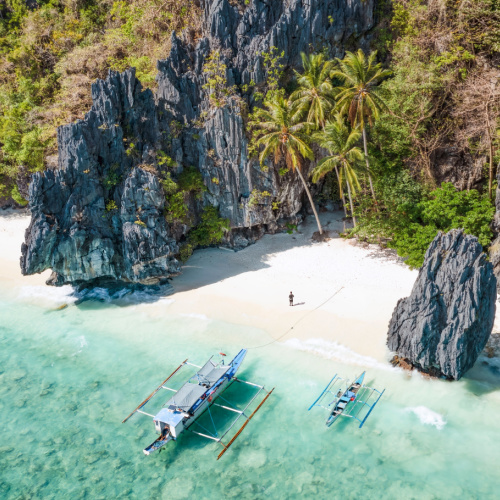
travelwild/Shutterstock
When Is the Best Time to Visit Philippines?
The best time to visit the Philippines is during the shoulder seasons of November to December and March to April. During these months, the weather is generally mild and sunny across most of the islands, with fewer crowds and lower prices than during the peak dry season of January to February.
Here are some of the benefits of visiting the Philippines during the shoulder seasons:
- Mild weather: The Philippines has a tropical climate, but the shoulder seasons offer mild and pleasant temperatures across most of the islands. This makes it ideal for sightseeing, exploring, and enjoying the outdoors.
- Smaller crowds: The shoulder seasons are less crowded than the peak dry season, so you’ll be able to enjoy the Philippines’ popular tourist attractions without having to deal with large crowds. This is especially important if you’re visiting popular destinations like Boracay, Palawan, and Cebu.
- Lower prices: Prices for flights, accommodation, and activities are generally lower during the shoulder seasons than during the peak dry season. This means you can save money on your trip without having to sacrifice quality.
Here are some specific examples of how you can enjoy the most of the Philippines during the shoulder seasons:
- November to December: The weather in November and December is typically sunny and warm, with occasional showers. This is a great time to visit for diving and snorkeling in the Visayas, island hopping in Palawan, and visiting the Banaue Rice Terraces.
- March to April: The weather in March and April is also typically sunny and warm, with occasional showers. This is a great time to visit for hiking in the Cordillera Mountains, swimming in the beaches of Boracay, and attending the Ati-atihan Festival in Kalibo.
While there are many great times to visit the Philippines, if you’re looking for the best weather and the most opportunities to enjoy the islands’ outdoor activities, then we recommend visiting during the shoulder seasons of November to December and March to April.
 Average Temperatures by Month
Average Temperatures by Month
|
Jan |
Feb |
Mar |
Apr |
May |
Jun |
Jul |
Aug |
Sep |
Oct |
Nov |
Dec |
| Fahrenheit |
78°
|
78°
|
80°
|
83°
|
85°
|
86°
|
85°
|
85°
|
85°
|
84°
|
82°
|
79°
|
| Celsius |
26°
|
26°
|
27°
|
28°
|
29°
|
30°
|
29°
|
29°
|
29°
|
29°
|
28°
|
26°
|
Climate in Philippines
Summer Season in Philippines
Often referred to as 'summer' in the Philippines, the dry season features hot and humid weather, particularly from March to May. This period is characterized by high temperatures and clear skies, making it ideal for beach activities, festivals, and exploring the islands. The dry season is the peak tourist period, especially during the cooler months of December to February.
Rainy Season in Philippines
The wet season in the Philippines is marked by the southwest monsoon, bringing frequent rainfall, which can be heavy and continuous, especially in the afternoons and evenings. Despite the rain, temperatures remain warm. This season sees fewer tourists and offers a more serene experience, although some outdoor activities might be affected by the weather.
Winter Season in Philippines
The Philippines does not experience a traditional winter season with cold weather. The closest to 'winter' would be the cooler part of the dry season, from December to February, where the climate is slightly cooler and more pleasant compared to the hot summer months, but it remains warm and suitable for beach and outdoor activities. The concept of winter, as understood in temperate regions, does not apply to the Philippines' tropical climate.
Our Recommendations
| Destination |
Jan |
Feb |
Mar |
Apr |
May |
Jun |
Jul |
Aug |
Sep |
Oct |
Nov |
Dec |
| Philippines |
 |
 |
 |
 |
 |
 |
 |
 |
 |
 |
 |
 |






